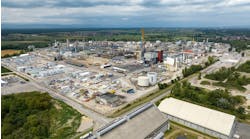Year after year, authors and industry consultants proffer advice on how to make a business successful. Some compare business to chess while others equate it to war. Regardless, they invariably stress the importance of sound decision-making. But what underpins that? What gives you the best chances of success? Planning. There’s no substitute for it. In “The Art of War,” Sun Tzu dedicates the entire first chapter to assessing the situation, planning and decision-making. If you prefer a scientist’s perspective, Louis Pasteur declared, “Fortune (Chance) favors the prepared mind.”
A plan isn’t a guarantee — but the best plans include flexibility and contingencies to ensure that even changes in direction remain guided by your leadership.
So, how do we best apply that line of thinking to projects? Techniques for successful planning begin early, with preplanning sessions conducted before the detailed project planning phase.
An effective preplanning session requires the right core project team and due diligence on the part of that team to properly prepare for those meetings. The objective is to present project goals — framed around a concept that already has been developed and supported by financial data — to senior stakeholders (Figure 1).
Figure 1. This provides an opportunity to present senior stakeholders with the project goals, framed around a concept that has been developed and supported by financial data.
Conducting a thorough fact-finding mission prior to the preplanning session equips project teams to lead an orderly and effective decision-making process.
Focus First On Four Factors
Performing an effective upfront planning session demands attention to four critical details.
Defining preplanning goals. After identifying a concept with substantial value, establish a launch team to do preplanning around that concept. Then, at a preplanning session, that team should present information to key stakeholders about how best to initiate the project. The first objective is to fundamentally define the goals of the project and identify relevant internal experts to involve in the planning phase. Adding definition to project goals requires an understanding of the expected end-result. While that will be discussed, negotiated and further defined in later stages of the planning phase, starting with a clear high-level vision puts the entire team on the same page.
Sometimes, there are multiple touchpoints for decision-makers. In preplanning, there is authority from the organization’s leadership to pursue the development of concepts and goals and to propose projects. After completion of some of the development, decision-makers can become more involved, beginning with a concept that already has been validated.
Preparing for decision-making. Senior leadership and management buy-in is critical because these stakeholders typically have authorization to approve project plans and make a financial commitment. An important aspect of the preplanning phase is to realize that senior executives and management, while providing the final sign-off of any project, may not have the availability to attend sessions in later planning stages. Presenting technical data that explain clearly defined goals and an agenda prior to a preplanning session affords these leaders the opportunity to evaluate a proposal, thus allowing them time to best prepare for the preplanning session, recommend substantial changes in direction or supply important resources.
Gathering technical input. Prior to the preplanning session, the team should interview technical stakeholders in the project; these may include engineers, technicians and operating staff with expertise in electrical, mechanical and construction areas of the project. A technical evaluation or study for any proposed project requires their input.
The operators of equipment at the plant are key stakeholders. After all, they are the people who actually use or maintain the equipment and have hands-on experience. To give these operators a voice, it’s important to engage them in understanding how the project goals will affect them. A designated supervisor capable of offering input about facility upgrades or replacement of existing equipment usually can represent them.
Technical experts and operations leaders have limited time available. So, make the most of the time you have with them. If you can’t get complete interviews and answers, you almost always can get consensus on who are the best people to provide those answers. If your project is important enough, management can prioritize making these employees available once the project plan is approved — but only if you know to include them in your plan.
Optimizing information. The project team aims to leverage knowledge from experts and coordinate information from all departments to present the best plan. Having access to and a positive working relationship with other departments within the company will influence the quality and clarity of the proposed project goals.
The project team can conduct scheduled interviews with individual department heads, gather information and then use those data to prepare an agenda for the planning session. For example, the department that tracks financials and scheduled maintenance will know about seasonal shutdowns that factor into design upgrades; they may dictate the best and least-invasive times to inspect equipment and make seamless upgrades.
Leveraging the knowledge of plant experts will help shape the preplanning session agenda and narrow the scope of the project. The project goals should focus on improvements the stakeholders want to realize but often lack the time or resources to address, such as improving plant efficiency.
Conducting thorough research prior to the planning session is an investment that saves time, opens communication among stakeholders and minimizes time commitments.
Align Goals
After conducting interviews, verifying data and drafting an agenda for a preplanning session, the project team should focus on achieving defined goals.
Providing metrics and solid documentation about facility upgrades increases buy-in from stakeholders and justifies the company’s financial commitment.
For example, a goal may be to reduce energy usage. The project team should be prepared to show statistical data on how to achieve that goal and the magnitude of resources required.
Metrics that bring project goals into focus include department progress milestones. There are internal drivers within all departments associated with achieving tangible goals. Aligning project goals with the overall goals of the organization and the metrics used to measure achievement of those goals will enhance buy-in from each group. These progress reports factor into the company’s annual management meetings and quarterly reports. Such data also allow the company to reflect, review progress and determine where best to allocate resources. Proper allocation of resources contributes to the bottom line and involves the support and investment of all departments. For your project to succeed, you must be prepared to show how the project supports those metrics and the overall goals of the team.
Scrutinize Scope
The key drivers and essential elements of scope aren’t always clear when looking at the physical size of equipment. However, after collecting data to review usage, it’s possible to diagnosis efficient and inefficient systems. This is where equipment size does matter.
For example, a large fired heater may appear to be the best solution — but greater savings may accrue by opting for a smaller more-efficient boiler. The initial assumption might be that a large fired heater provides the most direct heat transfer. Yet, a smaller, compact boiler may be a more-cost-effective alternative. The boiler not only cuts capital costs but also needs less space.
Presenting the best solution requires research. In this example, a boiler may appear to be the most economical choice but the team should focus on the overall energy efficiency of the selected model and its interconnectivity with the whole facility.
Figure 2. Once substantiated and documented, data can be presented during a planning session to facilitate a cost/benefit analysis.
Because of the dependency of interconnected systems, it’s important to evaluate the unique contribution of each component. For instance, in an air compressor system that’s not properly maintained, leaks may account for 30% of the air consumption. Here, simply sealing leaks would noticeably improve the overall system.
The interconnection of systems also provides an opportunity to look at more-advanced techniques, such as heat exchange networks and pinch analysis. Identifying simple changes in how systems relate can present solid energy savings with minimal capital outlay. Sometimes, just reevaluating the order in which equipment are placed can uncover opportunities that didn’t exist when the units originally were selected and installed.
Data collected on the efficiency of heating/cooling elements and how they interrelate (Figure 2) may identify important opportunities. Substantiate and document these data before presenting ideas based on them during the planning session. Without information on individual systems, it’s difficult to look at system interconnections and determine feasible alternatives or upgrades. Also, provide other information relevant to scope, such as capital costs and budget, to facilitate a cost/benefit analysis.
Furnish Financials
Another important aspect of the preplanning session is to provide financial data on upgrades and equipment costs. Management expects a high-level concept to include an estimate of the commitment, time and money they’re being asked to invest in the project. Having financial data readily available during a preplanning session helps the design team gain the support and trust of stakeholders.
During the preplanning session, focus on one piece of equipment that can be modified or delivered in a defined amount of time. Summarize how other systems can gain from this action. Show the larger value of the proposed change and leave the door open to revisit during future sessions the potential time and money benefits to other systems from the move. Documentation that supports the research will increase buy-in from stakeholders to conduct additional studies on other systems in the facility. A firm commitment by stakeholders to conduct or fund research prior to the planning phase is an investment that pays off in the future.
Guide Good Decisions
A successful preplanning session requires commitment by the project team to research the important details of proposed upgrades and modifications. Gathering data from multiple departments and providing an agenda that shows the design team has the knowledge and understanding to attain the stated goals increases stakeholder confidence.
For the project team, fact-finding research is a critical mission. These data will shape the agenda and provide the documentation stakeholders expect to review during a preplanning session. This research will allow the design team to conduct an organized and professional planning session serving the decision-making needs of senior stakeholders.
Ultimately, executives want to support worthwhile projects that have substantial potential. Your efforts help ensure that those projects rise to the top of the list and have the best chances of success. So plan early, plan often and keep your eyes open to the many risks and the opportunities ahead.
ERIC HOPKINS, PE, is a Cincinnati-based senior chemical process engineer and senior associate at SSOE Group. Email him at [email protected].




